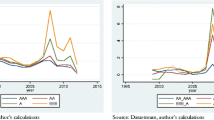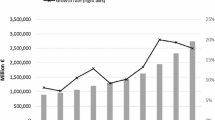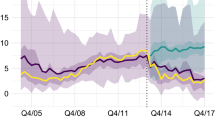Abstract
We provide new estimates of the association between the level of capital and the cost of capital for US banks by using the implied cost of capital as a measure of the cost of equity and by factoring in the effect of the cost of debt. With the important exception of the largest banks, we find that the cost of equity declines when the level of capital increases. This negative association is stronger after the onset of the 2007–2008 financial crisis. Banks’ cost of debt also declines when the level of capital increases. However, the weighted average cost of capital (WACC) remains unaltered when capital increases. The analysis of a sample of large banks yields different results: there is no discernible association between the level of capital and the costs of equity and debt for large banks, and their WACC increases with the level of capital.

Similar content being viewed by others
Data Availability
The datasets in this current study are not publicly available but are available from the corresponding author on reasonable request.
Notes
The different views of the potential effect of increasing capital requirements can be summarized by the reactions to regulation requiring a risk-based capital surcharge on systemically important U.S. bank holding companies. The Fed Chairwoman Janet Yellen commented that this surcharge was necessary to “bear the costs that their failure would impose on others.” Tim Pawlenty, the president of The Financial Services Roundtable, which is a trade group that represents big banks, said: “Regulators should reasonably address risk, but this rule will keep billions of dollars out of the economy.”.
For example, according to a former director of JP Morgan, “the first-order effect of increasing the ratio of common equity to total assets from 5 to 30% would clearly be very high. Assume that the annual cost of bank equity is 5 percentage points higher than the after-tax cost of bank deposits and debt…” (Elliott 2013).
We eliminate 24 banks that have a CRSP's permanent company identifier corresponding to more than one RSSD code. As in Baker and Wurgler (2015), we exclude Federal Reserve banks, foreign banks, functions related to deposit banking, non-depository credit institutions, and federal credit agencies.
However, these high levels of capital do not imply that regulatory capital is not binding for the majority of banks in our sample. We only observed the constrained choice of the level of capital. The optimal level may be lower, but banks may maintain capital above the regulatory level as a buffer against negative shocks that can push their regulatory capital below the minimum level. These shocks would force banks to raise additional equity or to cut dividends (for a more detailed discussion, see Berger et al. 1995).
Chava and Purnanandam (2010) contend that the ICC is by construction a forward-looking measure that captures the time variation in expected stock returns better than ex-post realized returns. Contrary to the negative cross-sectional relation between expected default risks and stock returns found in other studies that use realized returns, Chava and Purnanandam (2010) find a positive relation using the ICC.
Negative ICCs, which account for about 0.52% of the observations, are excluded from the sample. Other studies have matched earnings forecasts with market values at the end of an arbitrary month. For example, Gebhardt et al. (2001) use the end of April, while Hou et al. (2012) use the end of June. The choice does not take into account firms’ fiscal year. More importantly, using only one month per year imposes a significant loss of information. To ameliorate these concerns, we utilize monthly information from IBES, and then compute the average ICC for each quarter.
A concern with the ICC is that the potential of mergers in the banking industry can be reflected in market prices, which may impact the ICC. This concern is more relevant before the 2007–2008 financial crisis, which was a period of significant consolidation in the banking industry. Furthermore, in the earlier stages of the financial crisis, investors and analysts failed to anticipate the magnitude of the crisis. Thus, market prices and analysts’ EPS forecasts were overstated, which can affect the accuracy of the ICC as a measure of the cost of equity.
Bouwman et al. (2018) contend that behavioral theories (e.g., Gennaioli et al. 2015) can explain these results. Behavioral biases lead investors to underestimate the probability of bad times that results in low price spreads between well- and less-capitalized banks during good times. Investors gradually revise their beliefs during bad times, resulting in a gradual increase in the price spread between well- and less-capitalized banks.
In the analysis of the ICC, several bank characteristics are statistically significant only before the crisis: the ICC increases with Ln Book value and Loan concentration and is negatively associated with banks’ ROE and Real estate loans. After the crisis there is a negative association between the ICC, Deposit to assets and Nonperforming loans. The coefficient for High VIX is negative before the crisis, but positive afterwards. These findings can be explained because market participants assign a low value to risk during expansions and become more risk averse during contractions. In the analysis of the cost of debt, nonperforming loans are positively associated with banks’ cost of debt, but only after the crisis.
For instance, in our sample, the average ETOA for banks in the 5th decile is 8.91%, the average cost of equity is 9%, and the average cost of debt is 2.71%. For banks in the 10th decile, the average ETOA is 15.24%, the average cost of equity is 8.6%, and the average cost of debt is 2.55%. Thus, on average, banks with more equity have lower costs of equity and debt. However, we do not find this association between equity and the WACC. The WACC for banks in the 5th decile is 3.27% (2.71% × 91.09% + 9% × 8.91%), and the WACC for the best-capitalized banks is 3.472% (2.55% × 84.76% + 8.6% × 15.24%). Consistent with the M&M theory, substituting equity for cheaper debt does not have a significant effect on the banks’ overall cost of capital in our sample.
We also consider using banks’ weighted average effective state income tax rate, an IV proposed by Ashcraft (2008) and by Berger and Bouwman (2009, 2013). Schandlbauer (2017) finds that the state corporate income tax rate has a first order effect on banks’ capital structure. However, we cannot reject at conventional significance levels the null hypothesis that the coefficient of this measure equals zero in the reduced-form equation. The finding that the effective state tax rate is not correlated with the level of capital after considering the effect of other exogenous variables indicates that it is not a good IV candidate for bank capital in our sample.
We use xtabond2 in Stata IC/15 to estimate the dynamic GMM regression. See subsection 3.3 and Appendix 1 in Wintoki et al. (2012) for a description of the implementation of xtabond2. We use the “collapse option” to reduce the proliferation of instruments.
A caveat with this bailout argument proposed in the literature is that it requires that the market participants must presume that the government protects their investments, and banks will not repay the government for its support. However, investors lost the value of their investments in failed banks. We also know that government securities purchases and lending programs to support the financial system generated billions of dollars for taxpayers that indicate the majority of banks repaid the government for their support. Thus, investors overestimated the probability of bailouts in some well-known bank failures. However, we cannot exclude the bailout explanation because the government indeed intervened to protect the large financial institutions and the real economy. It is possible that investors in large financial institutions could have experienced larger losses without this government support.
References
Admati A, Hellwig M (2014) The bankers' new clothes: What’s wrong with banking and what to do about it. updated edition. Princeton University Press
Adrian T, Friedman E, Muir T (2015) The cost of capital of the financial sector. Staff Reports 755, Federal Reserve Bank of New York
Arellano M, Bond S (1991) Some tests of specification for panel data: Monte Carlo evidence and an application to employment equations. Rev Econ Stud 58:277–297
Ashcraft AB (2008) Does the market discipline banks? New evidence from regulatory capital mix. J Financ Intermed 17:543–561
Baker M, Wurgler J (2015) Do strict capital requirements raise the cost of capital? Bank regulation, capital structure, and the low-risk anomaly. Amer Econ Rev 105:315–320
Bekaert G, Hoerova M, Lo Duca M (2013) Risk, uncertainty and monetary policy. J Monet Econ 60:771–788
Beltratti A, Stulz RM (2012) The credit crisis around the globe: Why did some banks perform better? J Financ Econ 105:1–17
Berger AN, Bouwman CH (2009) Bank Liquidity Creation Rev Financ Stud 22:3779–3837
Berger AN, Bouwman CH (2013) How does capital affect bank performance during financial crises? J Financ Econ 109:146–176
Berger AN, Bouwman CH, Kick T, Schaeck K (2016) Bank liquidity creation following regulatory interventions and capital support. J Financ Intermed 26:115–141
Berger AN, DeYoung R, Flannery MJ, Lee D, Öztekin Ö (2008) How do large banking organizations manage their capital ratios? J Financ Serv Res 34:123–149
Berger AN, Herring RJ, Szegö GP (1995) The role of capital in financial institutions. J Bank Finance 19:393–430
Bouwman CH, Kim H, Shin S-OS (2018) Bank capital and bank stock performance. Mays Business School Research Paper No. 3007364. https://doi.org/10.2139/ssrn.3007364
Calomiris CW, Nissim D (2014) Crisis-related shifts in the market valuation of banking activities. J Financ Intermed 23:400–435
Campbell JL, Dhaliwal DS, Schwartz WC Jr (2012) Financing constraints and the cost of capital: Evidence from the funding of corporate pension plans. Rev Financ Stud 25:868–912
Chava S, Purnanandam A (2010) Is default risk negatively related to stock returns? Rev Financ Stud 23:2523–2559
Chen L, Da Z, Zhao X (2013) What drives stock price movements? Rev Financ Stud 26:841–876
Chen Y, Rhee SG, Veeraraghavan M, Zolotoy L (2015) Stock liquidity and managerial short-termism. J Bank Finance 60:44–59
Claus J, Thomas J (2001) Equity premia as low as three percent? Evidence from analysts’ earnings forecasts for domestic and international stock markets. J Finance 56:1629–1666
Cole RA, Gunther JW (1995) Separating the likelihood and timing of bank failure. J Bank Finance 19:1073–1089
Cornett MM, McNutt JJ, Strahan PE, Tehranian H (2011) Liquidity risk management and credit supply in the financial crisis. J Financ Econ 101:297–312
De Haas R, Van Horen N (2012) International shock transmission after the Lehman Brothers collapse: Evidence from syndicated lending. Amer Econ Rev 102:231–237
DeAngelo H, Stulz RM (2015) Liquid-claim production, risk management, and bank capital structure: Why high leverage is optimal for banks. J Financ Econ 116:219–236
Diamond DW, Rajan RG (2001) Liquidity risk, liquidity creation, and financial fragility: A theory of banking. J Polit Economy 109:287–327
Diamond DW, Rajan RG (2002) Bank bailouts and aggregate liquidity. Amer Econ Rev 92:38–41
Easton PD (2004) PE ratios, PEG ratios, and estimating the implied expected rate of return on equity capital. Accou Rev 79:73–95
Easton PD, Sommers GA (2007) Effect of analysts’ optimism on estimates of the expected rate of return implied by earnings forecasts. J Accou Res 45:983–1015
Elliott DJ (2013) Higher bank capital requirements would come at a price. Brookings Institute Internet posting. http://www.brookings.edu/research/papers/2013/02/20-bank-capitalrequirements-elliott (February 20, 2013)
Elton EJ (1999) Expected return, realized return, and asset pricing tests. J Finance 54:1199–1220
Fama EF, French KR (1992) The cross-section of expected stock returns. J Finance 47:427–465
Fama EF, French KR (1993) Common risk factors in the returns on stocks and bonds. J Financ Econ 33:3–56
Fama EF, MacBeth JD (1973) Risk, return, and equilibrium: Empirical tests. J Polit Economy 81:607–636
Fontaine J-S, Garcia R (2012) Bond Liquidity Premia Rev Financ Stud 25:1207–1254
Gandhi P, Lustig H (2015) Size anomalies in US bank stock returns. J Finance 70:733–768
Gandhi P, Lustig H, Plazzi A (2020) Equity is cheap for large financial institutions. Rev Financ Stud 33:4231–4271
Gebhardt WR, Lee CMC, Swaminathan B (2001) Toward an implied cost of capital. J Accou Res 39:135–176
Gennaioli N, Shleifer A, Vishny R (2015) Neglected risks: The psychology of financial crises. Am Econ Rev 105:310–314
Gordon JR, Gordon MJ (1997) The finite horizon expected return model. Financ Anal J 53:52–61
Gorton G, Winton A (2017) Liquidity provision, bank capital, and the macroeconomy. J Money Credit Bank 49:5–37
Gropp R, Mosk T, Ongena S, Wix C (2018) Banks response to higher capital requirements: Evidence from a quasi-natural experiment. Rev Financ Stud 32:266–299
Holtz-Eakin D, Newey W, Rosen HS (1988) Estimating vector autoregressions with panel data. Econometrica 56(6):1371–1395. https://doi.org/10.2307/1913103
Hou K, van Dijk MA, Zhang Y (2012) The implied cost of capital: A new approach. J Accou Econ 53:504–526
Huber K (2018) Disentangling the effects of a banking crisis: Evidence from German firms and counties. Amer Econ Rev 108:868–898
Ivashina V, Scharfstein D (2010) Bank lending during the financial crisis of 2008. J Financ Econ 97:319–338
Kashyap AK, Stein JC, Hanson S (2010) An analysis of the impact of ‘substantially heightened’ capital requirements on large financial institutions. Mimeo
Laeven L, Levine R (2009) Bank governance, regulation and risk taking. J Financ Econ 93:259–275
Li KK, Mohanram P (2014) Evaluating cross-sectional forecasting models for implied cost of capital. Rev Accou Stud 19:1152–1185
Merton RC (1973) An intertemporal capital asset pricing model. Econometrica 41(5): 867–887. https://doi.org/10.2307/1913811
Miller MH (1995) Do the M & M propositions apply to banks? J Bank Finance 19:483–489
Modigliani F, Miller MH (1958) The cost of capital, corporation finance and the theory of investment. Am Econ Rev 48:261–297
Ohlson JA, Juettner-Nauroth BE (2005) Expected EPS and EPS growth as determinants of value. Rev Accou Stud 10:349–365
Pastor L, Sinha M, Swaminathan B (2008) Estimating the intertemporal risk-return tradeoff using the implied cost of capital. J Finance 63:2859–2897
Peek J, Rosengren ES (2000) Collateral damage: Effects of the Japanese bank crisis on real activity in the United States. Am Econ Rev 90:30–45
Petersen MA (2009) Estimating standard errors in finance panel data sets: Comparing approaches. Rev Financ Stud 22:435–480
Schandlbauer A (2017) How do financial institutions react to a tax increase? J Financ Intermed 30:86–106
Thakor AV (2014) Bank capital and financial stability: An economic trade-off or a Faustian bargain? Annual Rev Financ Econ 6:185–223
Thakor AV (2016) The highs and the lows: A theory of credit risk assessment and pricing through the business cycle. J Financ Intermed 25:1–29
Ueda K, di Mauro BW (2013) Quantifying structural subsidy values for systemically important financial institutions. J Bank Finance 37:3830–3842
Wintoki MB, Linck JS, Netter JM (2012) Endogeneity and the dynamics of internal corporate governance. J Financ Econ 105:581–606
Acknowledgements
We are grateful to an anonymous referee and the editor, Mark Carey, for their helpful comments. We are also grateful to the participants at the 2017 Financial Management Association European Meetings, in Lisbon, for their suggestions.
Funding
The authors did not receive support from any organization for the submitted work.
Author information
Authors and Affiliations
Corresponding author
Ethics declarations
Conflicts of interests/Competing interests
The authors have no relevant financial or non-financial interests to disclose.
Additional information
Publisher's Note
Springer Nature remains neutral with regard to jurisdictional claims in published maps and institutional affiliations.
Supplementary Information
Below is the link to the electronic supplementary material.
Rights and permissions
Springer Nature or its licensor (e.g. a society or other partner) holds exclusive rights to this article under a publishing agreement with the author(s) or other rightsholder(s); author self-archiving of the accepted manuscript version of this article is solely governed by the terms of such publishing agreement and applicable law.
About this article
Cite this article
Mantecon, T., Almomen, A., Ren, H. et al. An analysis of the potential impact of heightened capital requirements on banks’ cost of capital. J Financ Serv Res 64, 325–368 (2023). https://doi.org/10.1007/s10693-023-00400-y
Received:
Revised:
Accepted:
Published:
Issue Date:
DOI: https://doi.org/10.1007/s10693-023-00400-y




